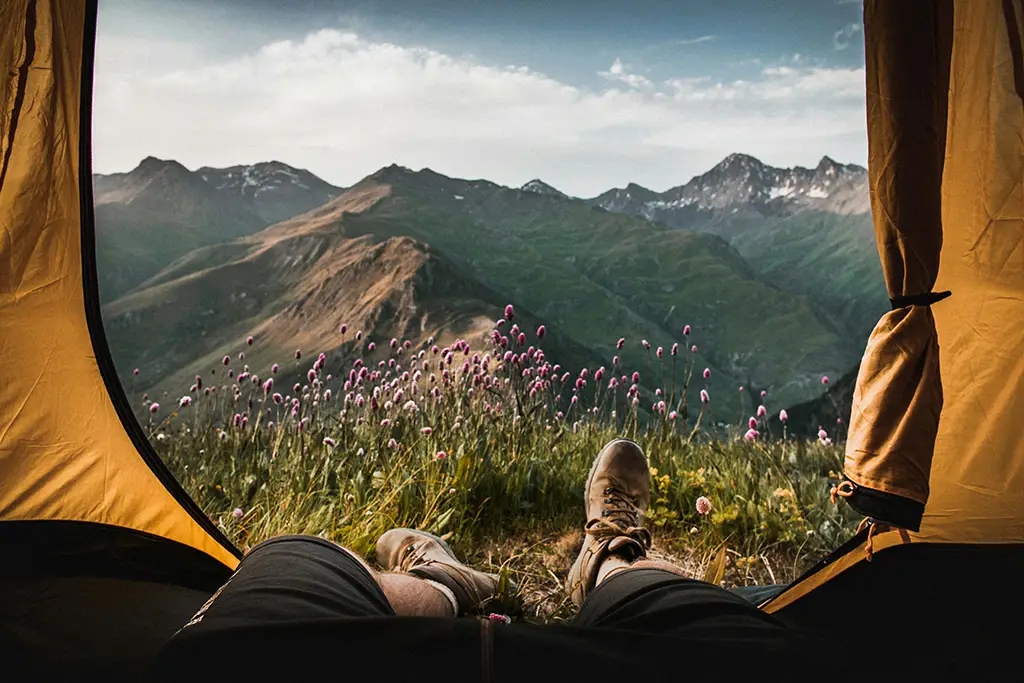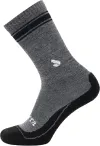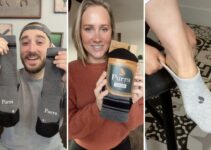- Home
- Foot Health Product Reviews
- Is There Such A Thing As ‘The Perfect Hiking Sock’? Old
Is There Such A Thing As ‘The Perfect Hiking Sock’?


Are blisters, hot spots, and skin irritation an obligatory rite of passage for recreational and serious hikers?
Is foot odor, sweaty feet, and fungal infection par for the course?
Does the holy grail of hiking socks exist, one that eliminates the need for pre-taping, adhesive strips, colloidal gel, and liquid skin? If mankind has landed on the moon, then why can’t there be a hiking sock that solves the problems of bromodosis—the scientific term for stinky feet—and Trichophyton rubrum, the fungal pathogen that causes athlete’s foot and toenail fungus?
The Same, Stale Blister and Odor Prevention Advice
In your quest to avoid blisters, hot spots and sweaty, smelly feet, you’ve probably heard this advice repeatedly:
Air your feet regularly. Change and clean socks regularly. Wash your feet regularly. Keep your toenails trimmed. Use a damp bandana to clean between your toes before falling asleep in your tent. Yada Yada Yada. We’ve all heard that advice ad nauseam. Unfortunately, this advice, along with repeated hot spot treatments and wearing sock liners often fails to prevent blisters and hot, sweaty, stinky feet.
“It’s Gotta Be The Shoes”
Are the painful and malodorous side of trekking primarily caused by inadequate footwear? Of course, some hikers, especially inexperienced ones, wear shoes that are too small or narrow. However, plenty of hikers spring for $300 hiking boots. Although high-end footwear feels infinitely more comfortable than the discount shoe outlet variety, a high price tag doesn’t always translate into preventing blisters, swelling, hotspots, bromodosis, and fungal infections.
So, if many hikers wear adequate footwear yet still suffer from blisters, hot spots, sweaty, stinky feel and fungus, it must obviously be the socks. It doesn’t take an M.D. in podiatry to figure that out. Yet, it does take an obsessive mindset to research the perfect hiking sock.

10 Must-Haves In A Hiking Sock For Long Treks
The golden unicorn of hiking socks must contain all 10 of the following:
Temperature Regulation: Is it too much to ask for a sock that keeps feet warm in cooler conditions by trapping and retaining heat close to the skin while also preventing overheating in warmer conditions? If traditional cultures like the Pueblo Native Americans could build adobe structures that are warm in winter and cool in summer, then surely a 21st-century sock can regulate foot temperature!
Moisture-Wicking: Moisture-wicking fabrics, often with a combination of natural and synthetic fibers, help transfer moisture away from the skin to the outer surface of the sock, promoting evaporation and keeping the feet dry.
Breathability: The perfect hiking sock would have breathable yarns to enhance breathability, allowing air circulation to cool the feet and reduce the risk of overheating.
Strategic Cushioning: You need padding in high-impact areas, such as the heel and ball of the foot, to provide shock absorption, reduce friction, and minimize the risk of blisters and foot fatigue.
Seamless Toe and Flat Stitching Minimizes friction and reduces the likelihood of chafing or irritation during prolonged wear.
Arch Support: Socks with built-in elastic bands or compression around the arch provide additional support, enhancing comfort and reducing fatigue on long hikes.
Durability: Are you tired of throwing away what you thought were high-quality hiking socks every year because they are holier than Swiss cheese? The perfect sock contains a reinforced heel and toe, ensuring the sock withstands the rigors of challenging terrain and extended use.
Fit and Compression: Socks with an asymmetrical (right and left) anatomical design conform to the foot’s shape, providing a snug yet comfortable fit. Proper-fitting socks also prevent slippage and bunching.
Exceptionally Soft: “I love wearing hiking socks that feel like sandpaper,” said nobody.
Antimicrobial Treatment: Last but far from least, the best hiking socks feature antimicrobial technology to inhibit the growth of bacteria and fungi, preventing foot odor and promoting overall foot health. The trick is finding an antimicrobial sock that doesn’t lose its efficacy after a handful of washes!

Is Merino Wool The Perfect Hiking Sock Material?
Yes and no. Pure merino wool socks succumb to wear and tear. That’s why the best hiking socks combine merino and synthetic fibers like nylon. Merino sheep wool is comfortable, eliminating the itchiness of other breeds of sheep wool. Merino is also thought to possess natural antibacterial and odor-resistant properties.
Merino sheep fleece is naturally antibacterial before the fleece is sheared. However, once the wool is washed, treated and dyed, the lanolin—a waxy substance produced by the sebaceous glands of sheep—is washed away. This erodes the antibacterial protection. Lanolin is washed out before raw wool is spun into yarn. In other words, by the time wool is turned into a sock, the antimicrobial properties of the lanolin are long gone.
Moreover, pure merino wool socks that cost $20 or more often fail to prevent hot spots, blisters, and bromodosis.
Zinc: A Potent Antimicrobial
A combination of merino wool and synthetic fiber in a hiking sock is necessary for comfort, durability, moisture wicking, and temperature regulation. But in order to protect feet from bacteria and fungus, an antimicrobial agent must be added.
Zinc is one of the most reliable natural elements to fight bacteria and fungi. Zinc ions interfere with the metabolic processes of bacteria and fungi. This disruption inhibits growth and reproduction, reducing bacteria, microbes, fungi, and other germs that cause odor and even potential skin infections.
The Best Hiking Sock of 2024
Out of all the merino wool hiking socks brands, only one meets or exceeds the 10-point standard and features zinc-infused yarns for durable, antimicrobial technology.
Purra Performance offers merino hiking socks for both men and women. Purra goes above and beyond with protection from bacteria and fungi by including a proprietary technology called Copptech.
Purra is the only brand we could find using Copptech’s EPA-registered technology. Purra hiking socks are embedded with Copptech’s zinc antimicrobial into the yarns and fibers of the socks.
After hitting the trail, you’ll find that by wearing Purra hiking socks, your hiking boots remain fresh-smelling. The high-quality merino wool yarns deliver a no-scratch, super-soft feel. A scientific term it’s not, but “ridiculously comfortable” is the best way to describe fit and feel.
If you could return every pair of socks that developed holes in them over the years, you’d probably have enough money to book that dream trip to Spain and finally be able to traverse the Camino.
Purra Performance is so confident in the quality of the hiking socks that it offers a lifetime guarantee.
Purra is currently offering our readers a buy two, get one free deal on Merino Wool Hiking socks. If you’re looking for the perfect hiking sock, Purra seems to have gone where no other hiking sock has gone before, offering superior softness, comfort and strategic cushioning for rocky terrain.
References:
Ongsri P, Leeyaphan C, Limphoka P, Kiratiwongwan R, Bunyaratavej S. Effectiveness and safety of zinc oxide nanoparticle-coated socks compared to uncoated socks for the prevention of pitted keratolysis: a double-blinded, randomized, controlled trial study. Int J Dermatol. 2021 Jul;60(7):864-867.
Related Posts
4.8/5 Reviews



Precision, Blister-Free Fit

Moisture Wicking

Temperature Regulation




